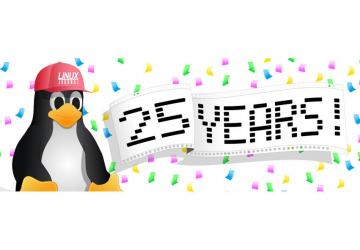Linux Journal at 25

It's been great. And we'll make it greater.
Most magazines have the life expectancy of a house plant.
Such was the betting line for Linux Journal when it started in April 1994. Our budget was a shoestring. The closest our owner, SSC (Specialized System Consultants) came to the magazine business was with the reference cards it published for UNIX, C, VI, Java, Bash and so on.
And Linux wasn't even our original focus. Phil Hughes, who ran SSC, wanted to start a free (as in speech, not beer) software magazine, which was hardly a big box office idea. I was a member of the email group doing the planning for that, which started, as I recall, in late 1993. Then, in early 1994, Phil announced to the group that he had made up his mind after finding "this Finnish kid" who had written a UNIX of sorts called Linux.
It was clear to Phil, and to approximately nobody else, that Linux was going to kick the ass of every UNIX in the world, plus all other operating systems as well, including the big one headquartered a few miles away from SSC's office in Seattle.
So maybe that's why Linux Journal is still here. We rode (while helping raise) the wave of ass-kicking that Linux has done in the world since our first issue, starting 25 years ago this month.
Our first publisher was Bob Young, who quickly left to leverage his on-the-job learnings into a Linux startup he called Red Hat. When I first met Bob, years later, I told him Phil said, "I taught Bob how to spell Linux." To my surprise, Bob replied, "That's true!"
Linux Journal for its first decade or so was headquartered in the Ballard district of Seattle and was very committed to on-site work. Though we had far-flung writers (Marcel Gagné in Montréal and Reuven Lerner in Israel), it was expected that those who could easily fly or drive to our offices would do that as often as they could. So I would fly up to Seattle from my home in the Bay Area, sometimes for a week per month. It was a very convivial and energetic scene.
Linux was a very hot item while the bubble gassed up. In fact, there was nothing hotter. The two biggest IPOs in 1999 were Red Hat and VA Linux. One wag observed that more VC money was spent on booths at Linux World Expos during that time than money was actually made in sales by the same companies. We reaped derivative benefits in the form of VC-funded advertising.
Then, when the dot-com bubble burst, most of our VC-based advertisers vanished overnight, and our losses were huge.
But somehow we persisted. I am sure that was due in large measure to Carlie Fairchild, who was hired in 1996 and quickly promoted to director of advertising sales. She eventually moved to the top, as publisher, replacing Phil, who decided that Carlie would be better at the job and that he'd rather start a new life somewhere else in the world anyway. I don't know a more patient, hard-working and sane person than Carlie, and we really needed all those virtues when Linux Journal shifted, without changing staff, from Seattle to Houston, and from SSC to Belltown Media.
The main difference after that shift was geographic distribution. While we were as centralized as could be in Seattle, we were now as distributed as could be, with a Houston address and not much more there.
Our next big change came in 2011, when we moved to all-digital publishing, because newsstand bookstores were dying (goodbye Borders), and the cost of printing became impossibly high. To our amazement and extreme satisfaction, we gained more subscribers in that move than we lost. (We love our subscribers.)
And then, in late 2017, we found ourselves in a position where we could no longer continue publishing. The advertisers we had were almost fully dependent on reader surveillance, and sponsoring magazines for their own worth had become passé. Selling our souls—and our readers' personal information—was not in line with our values, nor our community's. After much heartache, we decided to call it quits unless someone out there felt like rescuing us. Miraculously, there was someone: London Trust Media, owners of the popular VPN Private Internet Access and now our new corporate parent. That was the one company to stand alongside us and say "reader surveillance must stop". Not only did London Trust Media save us, but it argued that Linux Journal was so important to the community, we should make it even bigger, and better, and the company continues to support us along the way.
Since then, we've done our best to super-serve our core subscriber base while expanding our editorial scope to adjacent topics that always have been Linux features: free and open-source software, personal liberty and empowerment, and challenges in a shifting digital world that depends on Linux to the same degree that buildings and boats depend on gravity.
But Linux isn't done, and neither are we. I make that point in this April issue's feature story on kids. (Subscribers: look for the April issue in your inbox tomorrow, Tuesday, April 2.) Think for a moment about what happens to the world when every kid owns root for their whole lives as well as for their machines—and when they are as comfortable in shells on their Linux boxen as they are in their own clothes. Much cause for hope there.
So here's to the readers—and especially our subscribers—who have kept us alive and kicking ass for a quarter century. And here's to the futures those kids are going to write and debug for the world.










